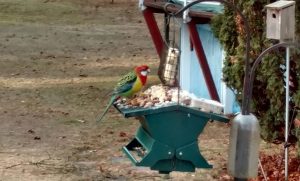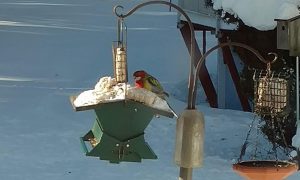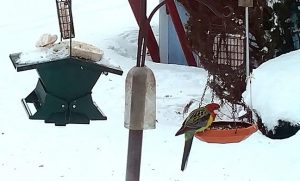Some residents along a stretch of Neck Road in Rochester have experienced a strange sighting at their bird feeders lately. An unlikely patron of the winter buffet of various birdseeds throughout the neighborhood, one could say.
No one knows from where it came, why it is here, and how come it has not succumbed to the cold New England winter climate, but, nonetheless, he (or she, for that matter) has become a full-fledged feathered friend to Rochester resident Jane Wrightington.
“We just can’t believe he’s still here!” said Wrightington during a phone interview.
Wrightington remembers the first time she looked out her window and spotted the odd ornithological object perched in a tree off the deck.
“Jane, look at that hawk up there, he’s just sitting there,” her husband said to her back in early December.
But that was no hawk. As far as Wrightington knew, there were no hawks around here with red, yellow, and green plumage.
“I said it kind of looks like a parrot,” Wrightington said. “No. It can’t be a parrot,” she said, hearing herself and second-guessing.
But, having a pet parrot of her own, Wrightington was right the first time she spoke.
“I tried to coax him down, tried to talk to him, and he flew from one tree to the next,” Wrightington said. “You would think in that cold weather he would be interested in people, especially if he were a pet of someone’s.”
But the parrot wasn’t having it.
No, the newcomer was just fine feeding from the birdfeeder and bathing in the Wrightingtons’ heated birdbath, even on freezing 5-degree mornings when Wrightington wondered how on Earth this tropical bird was surviving under these weather conditions.
Through rain, sleet, and snow, the bird could be seen, bathing and eating like it was on winter holiday in Rochester of all places.
Wrightington did a little research and she thinks she has identified the parrot as an Eastern rosella, a bird native to Australia.
All the neighbors have been feeding him, Wrightington said, and they all now lovingly refer to him as “Rico.”
“He’s not interested in being caught at all,” she said. “He’s perfectly comfortable being up in a tree.”
It’s just plain weird, Wrightington said. And if Rico thinks he is going to find a mate around here, “He’s going to be disappointed.”
Every day Wrightington would watch for Rico and, if a couple of days should pass, she would grow concerned. But sure enough, there he would appear, splishing and splashing at the birdbath and frolicking with the other birds at the birdfeeder as if Rico naturally belonged.
She contacted a local veterinarian who said, “There’s no way that bird is going to survive out there.”
But that was over nine weeks ago. Rico is still coming around, and here we are past the midpoint of winter.
“I don’t know whether somebody just let him out,” said Wrightington, “but if they did, he had to have been gradually acclimated to the weather. He couldn’t have escaped the winter without freezing to death.”
Or could he?
Wrightington thought about putting her own parrot, “Trouble” as he is called, out in the breezeway to talk to Rico, perhaps to communicate a little good sense into him and convince him to come inside, but Wrightington was sure that Trouble wouldn’t be able to take even a draft of winter air.
So these days, the neighbors just keep each other up to date about Rico sightings and now, well into February, the neighbors are pulling for Rico to make it to the spring.
“He’s like a pet now,” says Wrightington. “We miss him on days when he’s not there.”
By Jean Perry



Is anyone able to get RIco start feeding on the ground? If so, you can buy a clear plastic small critter carrier, turn it upside down, put seeds, millet under it, put a little peg in the front with a rope attached to it, to keep it opened on an angle, with at least 10 feet long! Get RIco to start feeding on the ground, let him approach the trap, do not pull on the string unless he is way inside the trap facing the back! I have captured a little budgie that way. It was easy! Please email me and
I will send you pics of the carrier I used! Yes, they can survived, providing that they got out in time to acclimatize to the colder temps. They can join a flock of sparrows or pigeons, learn where feeders are. We had a Rosella her in Toronto that was out for I think 4 months in the middle of the winter. We called him Christmas! He was finally captured and survived!